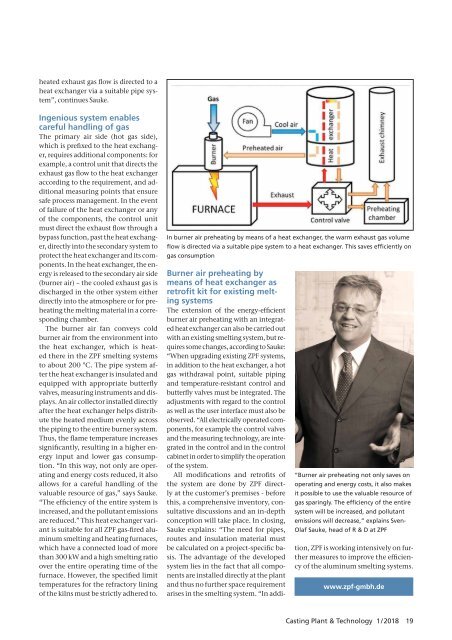CPT International 01/2018
- No tags were found...
You also want an ePaper? Increase the reach of your titles
YUMPU automatically turns print PDFs into web optimized ePapers that Google loves.
heated exhaust gas flow is directed to a<br />
heat exchanger via a suitable pipe system”,<br />
continues Sauke.<br />
<br />
<br />
The primary air side (hot gas side),<br />
which is prefixed to the heat exchanger,<br />
requires additional components: for<br />
example, a control unit that directs the<br />
exhaust gas flow to the heat exchanger<br />
according to the requirement, and additional<br />
measuring points that ensure<br />
safe process management. In the event<br />
of failure of the heat exchanger or any<br />
of the components, the control unit<br />
must direct the exhaust flow through a<br />
bypass function, past the heat exchanger,<br />
directly into the secondary system to<br />
protect the heat exchanger and its components.<br />
In the heat exchanger, the energy<br />
is released to the secondary air side<br />
(burner air) – the cooled exhaust gas is<br />
discharged in the other system either<br />
directly into the atmosphere or for preheating<br />
the melting material in a corresponding<br />
chamber.<br />
The burner air fan conveys cold<br />
burner air from the environment into<br />
the heat exchanger, which is heated<br />
there in the ZPF smelting systems<br />
to about 200 °C. The pipe system after<br />
the heat exchanger is insulated and<br />
equipped with appropriate butterfly<br />
valves, measuring instruments and displays.<br />
An air collector installed directly<br />
after the heat exchanger helps distribute<br />
the heated medium evenly across<br />
the piping to the entire burner system.<br />
Thus, the flame temperature increases<br />
significantly, resulting in a higher energy<br />
input and lower gas consumption.<br />
“In this way, not only are operating<br />
and energy costs reduced, it also<br />
allows for a careful handling of the<br />
valuable resource of gas,” says Sauke.<br />
“The efficiency of the entire system is<br />
increased, and the pollutant emissions<br />
are reduced.” This heat exchanger variant<br />
is suitable for all ZPF gas-fired aluminum<br />
smelting and heating furnaces,<br />
which have a connected load of more<br />
than 300 kW and a high smelting ratio<br />
over the entire operating time of the<br />
furnace. However, the specified limit<br />
temperatures for the refractory lining<br />
of the kilns must be strictly adhered to.<br />
In burner air preheating by means of a heat exchanger, the warm exhaust gas volume<br />
<br />
gas consumption<br />
“Burner air preheating not only saves on<br />
operating and energy costs, it also makes<br />
it possible to use the valuable resource of<br />
<br />
system will be increased, and pollutant<br />
emissions will decrease,” explains Sven-<br />
Olaf Sauke, head of R & D at ZPF<br />
Burner air preheating by<br />
means of heat exchanger as<br />
ing<br />
systems<br />
The extension of the energy-efficient<br />
burner air preheating with an integrated<br />
heat exchanger can also be carried out<br />
with an existing smelting system, but requires<br />
some changes, according to Sauke:<br />
“When upgrading existing ZPF systems,<br />
in addition to the heat exchanger, a hot<br />
gas withdrawal point, suitable piping<br />
and temperature-resistant control and<br />
butterfly valves must be integrated. The<br />
adjustments with regard to the control<br />
as well as the user interface must also be<br />
observed. “All electrically operated components,<br />
for example the control valves<br />
and the measuring technology, are integrated<br />
in the control and in the control<br />
cabinet in order to simplify the operation<br />
of the system.<br />
All modifications and retrofits of<br />
the system are done by ZPF directly<br />
at the customer’s premises - before<br />
this, a comprehensive inventory, consultative<br />
discussions and an in-depth<br />
conception will take place. In closing,<br />
Sauke explains: “The need for pipes,<br />
routes and insulation material must<br />
be calculated on a project-specific basis.<br />
The advantage of the developed<br />
system lies in the fact that all components<br />
are installed directly at the plant<br />
and thus no further space requirement<br />
arises in the smelting system. “In addition,<br />
ZPF is working intensively on further<br />
measures to improve the efficiency<br />
of the aluminum smelting systems.<br />
www.zpf-gmbh.de<br />
Casting Plant & Technology 1 / 2<strong>01</strong>8 19


















